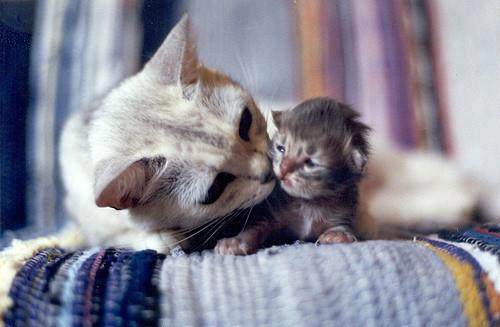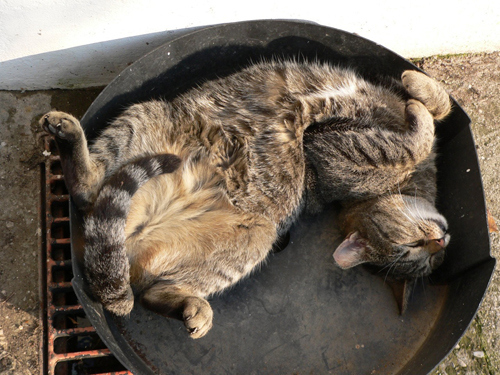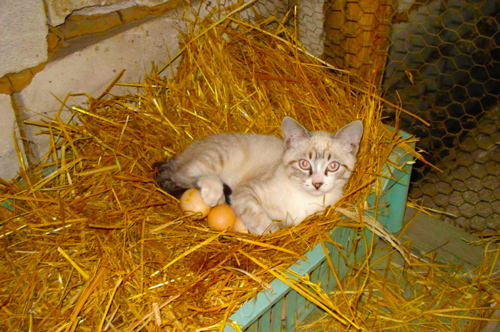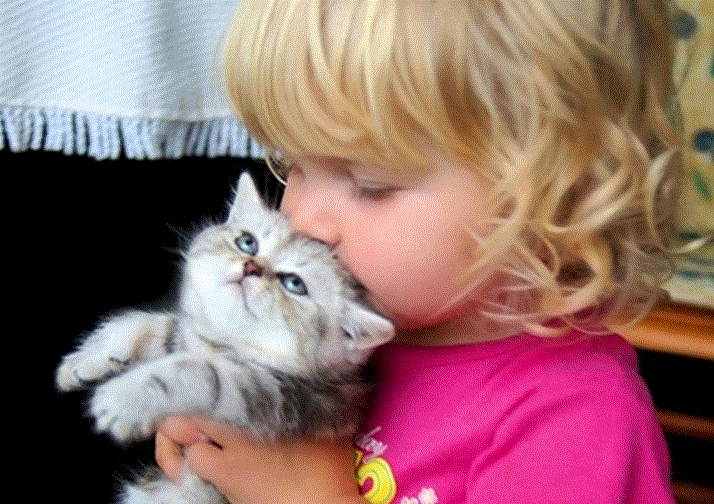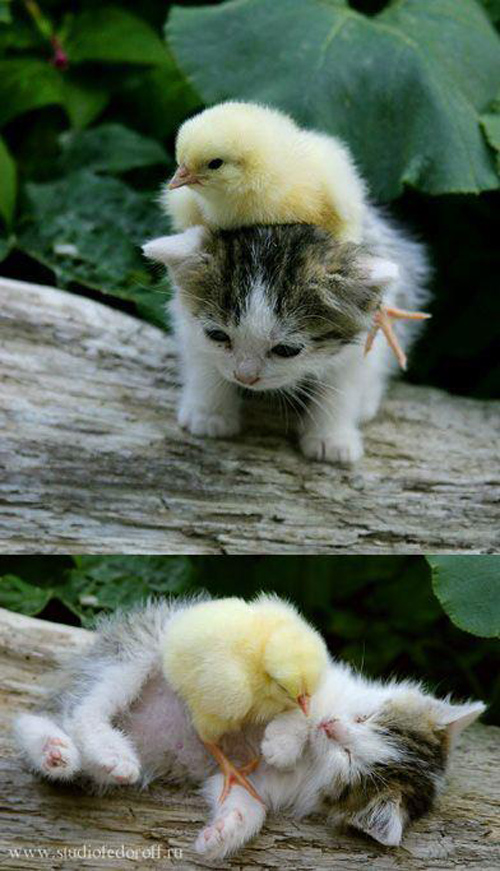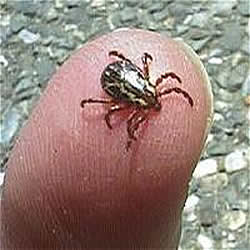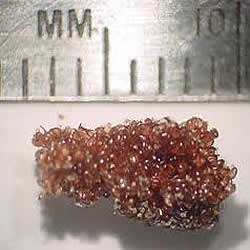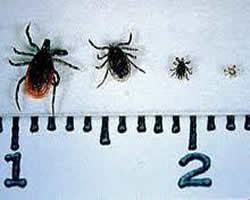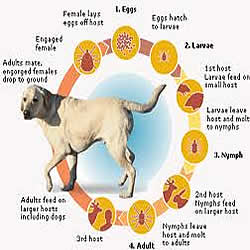There is nothing like a mother’s love
Archive for the ‘cats’ Category
Daily Paws Picture of the Day: Mother’s Love
Tuesday, April 10th, 2012The 25 Most Awkward Cat Sleeping Positions — Part 1
Monday, April 9th, 2012Do not try any of them unless you have skilled expertise with (a) sleeping and (b) being some kind of a cat. LOL!
1. The Full Situp: To achieve the full situp, you must begin with the genuine intention of exercising your abs and promptly fall asleep midway through the task. This position is extremely advanced and not recommended for amateur sleepers.
2. The Awkward Spoon: The goal here is not so much intimacy as it is the socially uncomfortable sharing of a physical space with someone. Bonus points if your arm falls asleep but you’re too embarrassed to move it.
3. The Semicircle: Tuck your tail between your legs and imagine that you are an omelet.
4. The Sunbather: The trick is to look like someone who is acting comfortable whilst also appearing extremely uncomfortable. Let’s take this excellent opportunity to coin the term “meta-comfortable”.
5. The Double Bed: You will need a partner for this one. The goal is not so much comfort as an expression of sheer, unadulterated greed.
Does your cat sleep in awkward positions? Snap a photo and send it to us.
Easter Pet Dangers
Friday, April 6th, 2012Today is Good Friday and many people are getting ready to celebrate the Easter festivities.
However, even though Easter is actually a time of celebration of rebirth for some Christians, their pets might not be ready to be resurrected if they have consumed one in all the five most dangerous pet dangers of Easter.
Easter Lilies
Although the Easter Lilly is one among the most common plants used to celebrate the arrival of Easter, it is the foremost lethal of plants to cats. Even merely ingesting a few of its leaves can lead to grave, acute renal and kidney failure which might result in your cat’s untimely death.
However, it is not simply the Easter Lilly that’s harmful to cats – all plant members of the Lilly family are potentially lethal.
As a friendly reminder stay those darned Easter lilies OUT OF YOUR HOUSE! There are dangerous and benign lilies out there, and it’s important to understand the distinction. Peace, Peruvian, and Calla lilies contain oxalate crystals that cause minor signs, such as tissue irritation to the mouth, tongue, pharynx, and esophagus – this ends up in minor drooling.
Locate a vet or call an emergency vet hotline.
Foil or Plastic Easter Grass
Easter grass is the second most commonly found dangerous part of Easter to pets, especially cats. This is as a result of the brightly colored foil makes an extraordinarily enticing cat toy.
Similar to tinsel used during Christmas time, this plastic and foil grass will cause intestinal distress in cats that needs immediate veterinary care.
Because it is hard to monitor, opt instead to use paper grass, or better yet, cat grass.
Chocolate Bunnies
It’s not Easter without those yummy chocolate bunnies! Just watch out that young children don’t inadvertently feed one to your cat or dog. Make sure that none of these chocolate bunnies, or different chocolate treats, are out of the reach of inquisitive pet noses. Chocolate will be extremely lethal to both dogs and cats and can conjointly require immediate veterinary attention.
Easter Eggs
Brightly colored laborious-boiled eggs will be a child’s delight and their pets too. However, day previous eggs that have not been properly handled or refrigerated will spoil on the inside, creating them lethal to pets.
When hiding these Easter eggs around your house or yard, be positive to stay count of them and build certain that they are all found. Another smart tip is to remind youngsters to throw away the eggs in the garbage after they are done eating them.
Baby Animals
Whilst it may appear tempting, getting a baby chick, baby bunny, or a baby duckling, may not be such a nice idea. Most of those baby animals can carry Salmonella which will then be passed on to your children and alternative pets.
If you actually do want to buy one of those baby animals for your child as a present, it is best if you wait till when Easter and then take your child to go to your local animal shelter or humane society. Here you will most undoubtedly realize a giant selection of baby bunnies, baby ducklings and baby chicks that are abandoned over the Easter weekend.
The best part is that not only can you teach your child about the importance of Easter, however you would conjointly have taught them the worth of pet adoption which is that the ultimate example of Easter rebirth.
House Guests
Since Easter is time best spent with family, take a few further precautions to confirm the security and comfort of your pets when guests come to go to. Create positive your pets have their own room or house in that they will get back when they become overwhelmed. Remind any visiting children to not feed Easter eggs or chocolates to your pets.
This is one of the Easter Bunny’s helpers!
Monday, April 2nd, 2012The real reason animals don’t talk is because they understand so much.
Friday, March 30th, 2012You don’t have to look like a friend to be a friend…
Wednesday, March 28th, 2012Good MEOWnin
Tuesday, March 20th, 2012Giving Thanks for Our Pets
Tuesday, November 22nd, 2011A charming video of Thanksgiving Pets. Give thanks for them. They always do such a great job of giving it back!
Have you heard your pet’s illness can be predicted?
Wednesday, November 9th, 2011
Although it is something I’d not specifically heard before, I am not surprised at this statement. It comes to us from VPI – Veterinary Pet Insurance who have been keeping statistics on our pets for many years.
They track which animals are prone to what types of injuries, illnesses and conditions and based on the type of breed, age and sex, can predict what illnesses your pet will be prone to.
To sum things up, pure bred dogs (and cats) have many more problems than mixed breeds. For example:
“A Golden Retriever is prone to hip dysplasia. It is more common in a Golden Retriever than a Labrador. German shepherds are even more prone than Golden Retrievers.”
Although insurance companies are skilled at predicting veterinary costs, they can’t factor into their numbers what a pet owner can do.
Example, preventing pet injury by securing your pets when you drive with them is an easy thing you can do to help keep them safe (and when you are driving – a pet on the loose can be a driving hazard to you too).
Pet owners who stay alert to changes in their pet’s behavior, appearance and who take care in what they feed can keep vet bills down by preventing or lessening health problems.
Also doing a little breed research on health problems that are typical for that breed will let you know what to be alert for if you choose one of these as a new pet.
Below is a chart from VPI on the most common pet medical conditions owners are making insurance claims for.
Top 10 pet medical conditions
| Dogs | Cats | Exotics |
| 1. Ear Infection | 1. Lower Urinary Tract Disease | 1. Bowel obstruction |
| 2. Skin Allergy | 2. Gastritis/Vomiting | 2. Gastritis/Vomiting |
| 3. Skin Infection/Hot Spots | 3. Chronic Renal Failure | 3. Bladder Infection |
| 4. Gastritis/Vomiting | 4. Hyperthyroidism | 4. Upper Respiratory Infection |
| 5. Enteritis/Diarrhea | 5. Diabetes | 5. Eye Infection |
| 6. Arthritis | 6. Enteritis/Diarrhea | 6. Cancerous Tumor Requiring Surgery |
| 7. Bladder Infection | 7. Skin Allergy | 7. Arthritis |
| 8. Soft Tissue Trauma | 8. Periodontitis/Dental Disease | 8. Skin Inflammation |
| 9. Non-cancerous Tumor | 9. Ear Infection | 9. Skin Abscess or Pressure Ulcer |
| 10. Hypothyroidism | 10. Upper Respiratory Infection | 10. Inflammation of Hair Follicles |
| Source: Veterinary Pet Insurance Co., 2010 data | ||
Do you have pet health questions you want answers for? Contact one of the vets in our directory or post your question in Ask A Pet Pro.

Pictures of ticks on dog
Thursday, October 20th, 2011We’ve had several people ask about ticks on dogs and what they look like on our Ask A Pet Pro blog. Here are some pictures of ticks and their eggs and baby ticks (known as seed ticks).
Ticks have a life cycle and are usually found on grasses and shrubs outside where they can drop on a warm passerby.
Here is some information from “The Family Vet” website on ticks.
Ticks have four life stages: egg, six-legged larva, eight-legged nymph and adult. After the egg hatches, the tiny larva (sometimes called a “seed tick”) feeds on an appropriate host. The larva then develops (molts) into the larger nymph. The nymph feeds on a host and then molts into an even larger adult. Both male and female adults find and feed on a host, then the females lay eggs sometime after feeding.
Ticks wait for host animals from the tips of grasses and shrubs (not from trees). When brushed by a moving animal or person, they quickly let go of the vegetation and climb onto the host. Ticks can only crawl; they cannot fly or jump. Ticks found on the scalp have usually crawled there from lower parts of the body. Some species of ticks will crawl several feet toward a host. Ticks can be active on winter days when the ground temperatures are about 45o Fahrenheit.
There are two groups of ticks, sometimes called the “hard” ticks and “soft” ticks. Hard ticks, like the common dog tick, have a hard shield just behind the mouthparts (sometimes incorrectly called the “head”); unfed hard ticks are shaped like a flat seed. Soft ticks do not have the hard shield and they are shaped like a large raisin. Soft ticks prefer to feed on birds or bats and are seldom encountered unless these animals are nesting or roosting in an occupied building.
Ticks prefer to attach on the head and neck, in the ears, around the anus, near the shoulder blades, and between the toes. A male and a female tick will usually attach together with the female becoming quite large as she engorges with blood. The female will detach and lay thousands of eggs in the environment. (Up to 2000 at a time!) These eggs hatch into larval ticks called “seed ticks” which sometimes are seen by the thousands on some dogs. Seed ticks must feed on blood from a dog or other mammal, then they fall to the ground and molt into a “nymph” stage. Again, the nymphs must find a mammalian host, feed on blood, and again fall to the ground and molt into adults.
When the adults find a host to feed on, the cycle is completed and begins again. This whole cycle can take from 2 months up to 2 years, and will tend to proceed faster in warm, moist weather. Because all life stages can feed on your dog, and because ticks lay large quantities of eggs, tick problems can escalate rapidly. Frequent and consistent treatment will be essential to ending and controlling the problem.
CONTROL OF TICK INFESTATION
There is no one-plan-fits-all strategy, but in short, killing and repelling ticks on the dog, and destroying and removing the eggs and nymphs from the house and yard are essential parts of any strategy.
It is best to work with your veterinarian to select safe and effective products. There are hundreds if not thousands of products sold today, many that are unproven and unsafe. Your veterinarian will generally have the latest improvements and safest agents available. Avoid untrained pet store personnel who have little training in chemistry and parasite control. Most are simply trying to sell you a product, not treat your pet in the best possible manner.
TOPICAL REPELLANTS such as Frontline tm and Advantage tm, are applied to the skin of the dog or cat where they spread out and over the entire skin area. These provide a sort of total body flea collar and are very effective in killing and repelling fleas. These agents have minimal toxicity for most pets: side effects are very rare. This is considered the “state of the art” in flea and tick control today. Avoid “knock off” products. We have seen poor performance and some severe toxic reactions from many off-brand chemicals sold in pet and retail stores.
DIPS provide quick and effective tick kill and can usually be mixed from a concentrate and poured or sponged onto your dog. You must dip about every two weeks as the dip will weaken in about that time. Do not rinse off the dip to provide residual anti-tick activity. We have had great success with Paramite Dip.
TOPICAL SPRAYS work well to quickly kill ticks, and a few will provide residual protection or prevent eggs from hatching out later. Sprays can be used between dipping, and in conjunction with topical and systemic medications. Alcohol-based sprays work best, but some people and dogs may be bothered by the fumes, so less effective water-based treatments are also available. Please ask about products currently available.
SHAMPOOS also kill adult ticks, and assist in cleaning eggs and dirt from the coat, but have minimal residual activity or effectiveness against tick eggs. Using shampoo then dipping or using a spray is the best strategy.
TICK COLLARS, if they are high quality, can help kill and repel ticks, but should be viewed as part of a tick control program and not as an end to the problem. Poor quality collars can be toxic to your dog, and can irritate the skin on the neck of your pet, so avoid the grocery store brands. Some new collars like Preventictm release their chemical ingredient onto the skin and not only kill and repel ticks, but prevent the transmission of tick-borne diseases. We do carry the Preventic collars but most people today opt for the topical Frontline.
FOGGERS and SPRAYS for the house and yard are useful in controlling the balance of your tick population. Newer foggers have time-release agents and providing kill for weeks after application. Many contain growth regulators to inhibit the hatching of eggs already in the environment. Foggers also apply their chemicals EVERYWHERE which happens to be where the ticks live, so these can be very useful in getting a bad tick problem quickly under control. Many sprays work in similar fashion but are better suited for direct application to baseboards and bedding areas where the heaviest infestations will occur.
Spaying the yard, grass, fences, patios and dirt areas with a yard spray made for ticks is also important to get tick problems under control. Spraying may be needed every 7-10 days in warmer weather, and you can do it yourself or hire professional exterminators to do the job for you. Be careful to keep your dogs away from freshly sprayed areas until they are dry. Most veterinarians will carry high quality yard sprays for home use.
